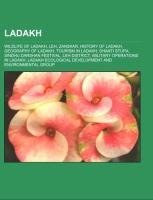
-
 Anglický jazyk
Anglický jazyk
Ladakh
Autor: Source: Wikipedia
Source: Wikipedia. Pages: 44. Chapters: Wildlife of Ladakh, Leh, Zanskar, History of Ladakh, Geography of Ladakh, Tourism in Ladakh, Shanti Stupa, Sindhu Darshan Festival, Leh district, Military operations in Ladakh, Ladakh Ecological Development and Environmental... Viac o knihe
Na objednávku
15.39 €
bežná cena: 17.10 €
O knihe
Source: Wikipedia. Pages: 44. Chapters: Wildlife of Ladakh, Leh, Zanskar, History of Ladakh, Geography of Ladakh, Tourism in Ladakh, Shanti Stupa, Sindhu Darshan Festival, Leh district, Military operations in Ladakh, Ladakh Ecological Development and Environmental Group, Lamayuru Monastery, Nubra Valley, Thinlas Chorol, 12th Gyalwang Drukpa, Leh-Manali Highway, Ladakhi language, The Druk White Lotus School, Suru Valley, Leh Kushok Bakula Rimpochee Airport, Ladakh Autonomous Hill Development Council, Leh, The Ladakh Scouts, Alchi, Rangdum, Students' Educational and Cultural Movement of Ladakh, Brokpa, Karakash River, Stok Kangri, Sankoo, Kang Yatze, Leh Palace, Magnetic Hill, Tanglang La, Ladakh Buddhist Association, Garpon, Datun sahib, Kanji, Jammu and Kashmir, Skiu-Kaya, Nanga Sago, Dah Hanu, Doda River, Markha River, Tsarap River, Rupshu, Pangong range, Salt Valley, Yapola River, Sengge-La, Yarab Tso Hotel, Tegar. Excerpt: Ladakh (Tibetan script: ; Wylie: la-dwags, Ladakhi , Hindi: , Urdu: ; "land of high passes") is a region of Jammu and Kashmir, the northernmost state of the Republic of India. It lies between the Kunlun mountain range in the north and the main Great Himalayas to the south, inhabited by people of Indo-Aryan and Tibetan descent. It is one of the most sparsely populated regions in Kashmir. Historically, the region included the Baltistan (Baltiyul) valleys, the Indus Valley, the remote Zangskar, Lahaul and Spiti to the south, Aksai Chin and Ngari, including the Rudok region and Guge, in the east, and the Nubra valleys to the north. Contemporary Ladakh borders Tibet to the east, the Lahaul and Spiti to the south, the Vale of Kashmir, Jammu and Baltiyul regions to the west, and the trans-Kunlun territory of Xinjiang to the far north. Ladakh is renowned for its remote mountain beauty and culture. It is sometimes called "Little Tibet" as it has been strongly influenced by Tibetan culture. In the past Ladakh gained importance from its strategic location at the crossroads of important trade routes, but since the Chinese authorities closed the borders with Tibet and Central Asia in the 1960s, international trade has dwindled except for tourism. Since 1974, the Government of India has successfully encouraged tourism in Ladakh. Since Ladakh is a part of the Kashmir dispute, the Indian military maintains a strong presence in the region. The largest town in Ladakh is Leh. It is one of the few remaining abodes of Buddhism in South Asia, including the Chittagong Hill Tracts, Bhutan and Sri Lanka; a majority of Ladakhis are Tibetan Buddhists and the rest are mostly Shia Muslims. Some Ladakhi activists have in recent times called for Ladakh to be constituted as a union territory because of its religious and cultural differences with predominantly Muslim Kashmir. Phyang Gompa, Ladakh, IndiaRock carvings found in many parts of Ladakh show that the area has been inhabited from Neolithic
- Vydavateľstvo: Books LLC, Reference Series
- Rok vydania: 2015
- Formát: Paperback
- Rozmer: 246 x 189 mm
- Jazyk: Anglický jazyk
- ISBN: 9781156776667






 Ruský jazyk
Ruský jazyk 





